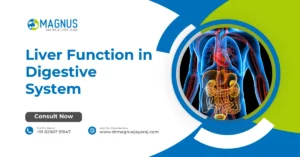The liver plays a crucial role in maintaining our overall health, and this is no different for children. From infancy to adolescence, a healthy liver is vital for growth, development, and overall well-being. Specifically, we will explore the ways parents can actively contribute to their child’s liver health and touch upon the significance of treating liver disease in infants and pediatric chronic liver disease. In this article, we will delve into the importance of promoting liver health in children and address the key concerns surrounding pediatric liver diseases.
Nutrition for a Healthy Liver
Proper nutrition is essential for supporting liver function in children with liver disorders. Whether treating liver disease in infants or managing pediatric chronic liver disease, a specialized diet aids in recovery, supports growth, and reduces complications. A well-balanced nutritional plan can help restore liver function and improve overall health in affected children.
- Balanced Macronutrients Support Liver Recovery: A liver-friendly diet should include appropriate proportions of carbohydrates, proteins, and healthy fats. For children with pediatric chronic liver disease, sufficient protein intake is crucial to support growth, repair liver tissue, and prevent muscle wasting, while complex carbohydrates provide stable energy and prevent hypoglycemia.
- Vitamins and Minerals Play a Vital Role: Fat-soluble vitamins (A, D, E, and K) are often deficient in children with liver disease due to impaired bile production. Supplementation is essential, particularly in cases of liver disease in babies, to support bone health, immunity, and blood clotting functions.
- Frequent Small Meals Help Maintain Energy: Infants and children with liver dysfunction may experience early satiety or poor appetite. Offering frequent, nutrient-dense meals helps prevent malnutrition and stabilizes blood sugar levels, which is important when treating liver disease in infants.
- Medium-Chain Triglycerides (MCTs) Are Better Tolerated: In pediatric chronic liver disease, the digestion of long-chain fats can be impaired. MCTs, found in specialized formulas, are easier to absorb and provide a quick energy source without requiring bile salts, making them suitable for managing liver disease in children.
Hydration and Liver Health
Maintaining proper hydration is essential for supporting liver function, especially in children suffering from hepatic conditions. In cases such as treating liver disease in infants or managing pediatric chronic liver disease, fluid balance directly influences detoxification, circulation, and nutrient transportation. Since the liver relies on water to flush out toxins and regulate metabolic processes, dehydration can worsen symptoms and increase the risk of complications related to liver disease in babies and older children. Understanding how to detox your liver naturally begins with ensuring consistent and adequate hydration.
- Supports Detoxification and Waste Removal: The liver filters toxins from the blood, a process that requires adequate fluid levels. Without proper hydration, this function becomes sluggish, leading to toxin buildup, which can further harm the liver, especially in pediatric chronic liver disease cases.
- Prevents Electrolyte Imbalance: Children with liver disease often experience fluid shifts and electrolyte disturbances due to impaired liver and kidney interactions. Adequate hydration helps maintain sodium, potassium, and chloride levels, which is vital for cellular function and preventing complications like confusion or fatigue.
- Improves Circulatory Efficiency: Water maintains blood volume and helps deliver oxygen and nutrients efficiently throughout the body. In conditions like liver disease in children, proper circulation ensures the liver cells receive the nourishment required for repair and regeneration.
- Reduces the Risk of Constipation and Ammonia Build-Up: In advanced liver conditions, poor hydration can lead to constipation, which slows the removal of ammonia from the body. This is especially concerning in treating liver disease in infants and children, as elevated ammonia levels can cause cognitive symptoms and further burden the liver.

Regular Physical Activity
Regular physical activity, adapted to age and medical condition, plays a supportive role in managing liver health in children. While medical treatment remains primary in cases like treating liver disease in infants or managing pediatric chronic liver disease, gentle exercise can help maintain physical strength, enhance mood, and improve overall metabolic function. It must be carefully tailored based on the severity and cause of liver dysfunction, as overexertion can be harmful, especially in children with limited energy reserves. Exercise for liver disease is most beneficial when supervised and personalized.
- Enhances Muscle Mass and Prevents Wasting: Children with liver disease often face muscle loss due to altered metabolism and reduced appetite. Light physical activity helps preserve muscle strength and improves endurance, which is especially important in pediatric chronic liver disease where growth and development are at risk.
- Supports Mental and Emotional Health: Chronic liver disease can lead to emotional stress, fatigue, and social withdrawal in children. Engaging in physical activity like walking, swimming, or age appropriate play can help improve mental well-being and reduce anxiety, enhancing the child’s quality of life.
- Improves Metabolic Function and Circulation: Mild exercise supports better glucose regulation, which is critical in liver disease in babies and older children, where the liver’s role in sugar metabolism is impaired. Improved circulation also aids nutrient delivery and waste removal, helping the liver function more efficiently.
- Reduces Risk of Secondary Complications: Physical inactivity in children with liver disease increases the risk of obesity, insulin resistance, and poor bone health. Controlled movement and regular gentle activity help mitigate these risks and support better long-term outcomes.
Monitoring Medication Use
In children with liver disorders, careful monitoring of medication is vital to prevent further liver damage and ensure therapeutic safety. The liver is responsible for metabolizing many drugs, and impaired liver function such as in pediatric chronic liver disease can alter how medications are processed. Especially in cases like treating liver disease in infants or managing liver disease in babies, even routine medications must be selected and dosed with caution to avoid toxicity or reduced efficacy. Unexpected symptoms like stomach pain in kids may also signal adverse drug reactions and should not be overlooked.
- Adjusting Dosages Based on Liver Function: Children with compromised liver function may not metabolize drugs at the normal rate, leading to accumulation and potential toxicity. Dosing must be adjusted based on liver enzyme levels and overall liver performance, particularly in those with long-standing pediatric chronic liver disease.
- Avoiding Hepatotoxic Medications: Some commonly used medications, including certain antibiotics, anti-seizure drugs, and over-the-counter pain relievers, can be harmful to the liver. In cases of liver disease in children, healthcare providers must carefully assess risk versus benefit before prescribing any potentially hepatotoxic drug.
- Monitoring for Side Effects and Drug Interactions: Children with liver disease may react differently to medications or experience exaggerated side effects. Regular monitoring for symptoms like jaundice, abdominal pain, or altered mental status is crucial, especially when introducing new treatments for underlying liver disease in babies or infants.
- Ensuring Compliance and Proper Administration: In treating liver disease in infants or young children, correct timing, formulation (liquid vs. tablet), and administration method are essential. Missed or improperly administered doses can compromise treatment outcomes and complicate the child’s overall care plan.
Treating Liver Disease in Infants
Liver disease in infants requires timely diagnosis, careful monitoring, and individualized treatment strategies to prevent long-term damage. Early identification of liver disease in babies is essential, as delayed treatment can result in life-threatening complications. Since pediatric chronic liver disease can stem from various causes ranging from genetic disorders to infections understanding liver disease in children causes is crucial in determining the right approach for each case. Supportive therapies, including nutritional interventions and safe natural options like herbs for fatty liver, may also complement medical care when appropriate.
- Early Detection Through Newborn Screening and Observation: Many liver conditions in infants, such as biliary atresia or metabolic liver disease, can be detected through newborn screening or signs like jaundice persisting beyond two weeks. Prompt evaluation with liver function tests, ultrasound, and sometimes biopsy is essential to confirm the diagnosis and initiate treatment early.
- Nutritional Support and Specialized Feeding Plans: Infants with liver disease often struggle with fat absorption and growth delays. Specialized formulas containing medium-chain triglycerides (MCTs) and fat-soluble vitamin supplements are used to support growth and prevent malnutrition during the course of treating liver disease in infants.
- Medical Management to Stabilize Liver Function: Medications may be prescribed to manage symptoms such as itching, bleeding tendencies, or elevated bile acids. In certain types of pediatric chronic liver disease, medications also help delay the progression of fibrosis and support liver regeneration.
- Surgical Intervention and Liver Transplantation: In severe cases like biliary atresia, surgical procedures such as the Kasai procedure may be required to restore bile flow. If liver function continues to decline, liver transplantation becomes a life-saving option, offering a long-term solution in cases of irreversible liver damage.
Preventing Liver Disease in Children
Preventing liver disease in children involves a combination of healthy lifestyle habits, early detection, vaccinations, and avoiding known risk factors. Since liver disease in children causes can range from infections and metabolic disorders to genetic and autoimmune conditions, prevention strategies should be both proactive and comprehensive. While treating liver disease in infants is critical once diagnosed, the goal is to reduce the incidence and severity of liver disease in babies and young children through targeted preventive efforts. Addressing early signs of fatty liver disease is also vital, as it is increasingly seen in the pediatric population.
- Promoting Healthy Nutrition and Physical Activity: A balanced diet low in processed sugars and saturated fats helps prevent non-alcoholic fatty liver disease, which is becoming more common in children. Combined with regular physical activity, this reduces the risk of obesity a major contributor to pediatric chronic liver disease.
- Timely Vaccinations Against Hepatitis Viruses: Hepatitis A and B are significant infectious causes of liver disease in children. Administering these vaccines according to the recommended schedule protects against potentially serious liver infections and reduces the overall disease burden.
- Avoiding Unnecessary Medications and Toxins: Overuse of certain medications, such as acetaminophen, can lead to liver damage in children. Parents and caregivers should use medications only under medical supervision and avoid exposure to harmful chemicals that may contribute to liver disease in babies.
- Screening and Genetic Counseling for At-Risk Families: For families with a history of liver disorders or consanguineous marriages, early genetic screening can help identify infants at risk. Detecting conditions like alpha-1 antitrypsin deficiency or Wilson’s disease early allows for timely intervention and minimizes the severity of pediatric chronic liver disease.
Conclusion
Promoting liver health in children is an investment in their future well-being. By focusing on a nutritious diet, regular physical activity, and proper hydration, treating liver disease in infants is made possible. Additionally, staying informed about the signs of liver disease in infants and pediatric chronic liver disease empowers parents to seek timely medical attention when needed. Remember, a healthy liver sets the stage for a vibrant and active childhood, paving the way for a healthier life ahead.
Read Also: Liver Transplant in Chennai.




